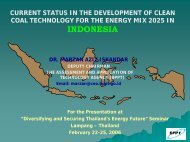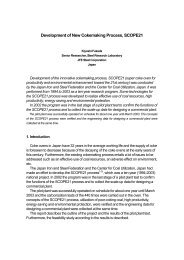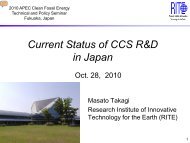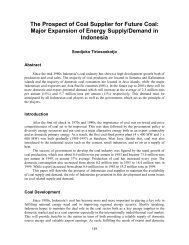Executive SummaryExhibit ES-3: Illustration of Graduated Levels of Requirements Common <strong>to</strong> aCO 2 Capture <strong>Ready</strong> Plant, a Transport <strong>Ready</strong> Plant, and a S<strong>to</strong>rage <strong>Ready</strong> PlantComponent <strong>CCS</strong> <strong>Ready</strong> Level 1 <strong>CCS</strong> <strong>Ready</strong> Level 2 <strong>CCS</strong> <strong>Ready</strong> Level 3Conflicting Usesand RightsCost Estimate for<strong>CCS</strong> FacilitiesEnvironmental,Safety, and OtherApprovalsPublic Awarenessand EngagementSources forEquipment,Materials, andServicesOngoingObligationsTransport: Identify any conflicting land use activity, as well as feasibility of land/portaccess.S<strong>to</strong>rage: Identify any conflicting surface and subsurface uses, as well as feasibility ofaccess <strong>to</strong> site(s).Capture: Prepare preliminary economicanalysis of capture facilities.Transport: Prepare preliminary economicanalysis for transport facilities, andestimate the cost of transportation for thecapture plant.S<strong>to</strong>rage: Prepare preliminary economicanalysis for s<strong>to</strong>rage facility includingcapital and operation and maintenancecosts, and estimate the cost of s<strong>to</strong>ragefor the capture plantCapture: Identify all approvals that willneed <strong>to</strong> be obtained for retrofitting capturefacilities.Transport: Identify all approvals that willneed <strong>to</strong> be obtained for transporting CO2.S<strong>to</strong>rage: Identify all approvals that willneed <strong>to</strong> be obtained for s<strong>to</strong>rage site.Capture: Notify public of eventual capturefacilities retrofit via web site and otheractions.Transport: Notify public of chosentransport method(s) and corridor(s) viaweb site and other actions.S<strong>to</strong>rage: Notify public of eventual s<strong>to</strong>ragesite via web site and other actionsNoneCapture: Prepare preliminary economicfeasibility study based on technicalfeasibility study.Transport: Conduct preliminary economicfeasibility study, based on technicalfeasibility study, including cost oftransportation for the capture plant.S<strong>to</strong>rage: Conduct preliminary economicfeasibility study based on technicalfeasibility study, including the cost ofs<strong>to</strong>rage for the capture plantCapture: Conduct feasibility studies forobtaining all approvals for retrofitting.Transport: Conduct feasibility studies forobtaining all approvals for transportationfacilities.S<strong>to</strong>rage: Conduct feasibility studies forobtaining all approvals for s<strong>to</strong>rage site.Capture: Seek public engagement inplanning of capture facilitiesTransport: Seek public engagement intransportation planning.S<strong>to</strong>rage: Seek public engagement ins<strong>to</strong>rage site planning.Capture: Compile list of companies whocan supply construction and operationservices <strong>to</strong> capture facilities.Transport: Compile list of companies whocan supply equipment, materials andservices needed for construction andoperation of CO2 transportation.S<strong>to</strong>rage: Compile list of companies whocan supply equipment, materials andservices needed for construction andoperation of s<strong>to</strong>rage siteCapture: File periodic reports with regula<strong>to</strong>rs on status of Capture <strong>Ready</strong>.Transport: File periodic reports with regula<strong>to</strong>rs on status of Transport <strong>Ready</strong>.S<strong>to</strong>rage: File periodic reports with regula<strong>to</strong>rs on status of S<strong>to</strong>rage <strong>Ready</strong>.Transport: Resolve any issueswith conflicting surface and subsurfaceuses, and land/port access.S<strong>to</strong>rage: Resolve any issues withconflicting surface and sub-surfaceuses, and site access.In addition <strong>to</strong> Level 2 requirement,prepare follow-on economicfeasibility study based on technicalinformation provided in DBM.Capture: Prepare key documentsfor obtaining all approvals.Transport: Prepare keydocuments for obtaining allapprovals for transportationfacilities.S<strong>to</strong>rage: Prepare key documentsfor obtaining all approvals fors<strong>to</strong>rage site.Capture: In addition <strong>to</strong> Level 2requirement, encourage publicengagement in approval process.Transport: In addition <strong>to</strong> Level 2requirement, encourage publicengagement in transportationapproval process.S<strong>to</strong>rage: In addition <strong>to</strong> Level 2requirement, encourage publicengagement in s<strong>to</strong>rage siteapproval process.Contact companies and negotiatenonbinding letters of intent <strong>to</strong> bidon project.Capture: In addition <strong>to</strong> Level 2requirement, respond <strong>to</strong> manda<strong>to</strong>rytrigger mechanism <strong>to</strong> retrofitcapture facilities.Transport: In addition <strong>to</strong> Level 2requirement, respond <strong>to</strong> manda<strong>to</strong>rytrigger mechanism <strong>to</strong> developtransport facilities.S<strong>to</strong>rage: In addition <strong>to</strong> Level 2requirement, respond <strong>to</strong> manda<strong>to</strong>rytrigger mechanism <strong>to</strong> develops<strong>to</strong>rage site for injection.23 February 2010 6
Chapter 1: Introduction1. IntroductionThe <strong>International</strong> Energy Agency (IEA) projects that the world’s primary energyconsumption will increase by 40% above 2007 levels by the year 2030, driven primarily byincreased demand for electricity. 1 Globally, coal fuels the generation of 42% of electricity<strong>to</strong>day, and is expected <strong>to</strong> remain a significant source for power generation in the future. 1Other fossil fuels, such as oil and natural gas, are also widely used in the power andindustrial sec<strong>to</strong>rs and their demand is expected <strong>to</strong> rise as well in the future. 1Counterbalanced against this rising demand for fossil fuel energy is a growing internationalrecognition of climate change and an increasing aspiration <strong>to</strong> control greenhouse gas (GHG)emissions. The burning of fossil fuels accounts for nearly 57% of global greenhouse gasemissions. 2 Governments may impose GHG emissions limits on power plants and otherlarge emitters <strong>to</strong> control emissions.While improvements in energy efficiency and greater use of renewable energy will help <strong>to</strong>reduce the carbon intensity of energy consumption, the IEA projects a high demand for thetechnology <strong>to</strong> geologically s<strong>to</strong>re carbon dioxide (CO 2 ) emissions that may be captured fromfossil-fuel based plants. CO 2 capture, transport, and s<strong>to</strong>rage (<strong>CCS</strong>) technology allows forglobal CO 2 emissions <strong>to</strong> be reduced even as consumption of fossil fuels increases.IEA’s Energy Technology Perspectives 2008 states that the application of <strong>CCS</strong> in powergeneration and industry is “the most important single new technology for CO 2 savings.” TheIEA defines <strong>CCS</strong> as a process whereby CO 2 is captured from gases produced by fossil fuelcombustion, compressed, transported and injected in<strong>to</strong> deep geologic formations for permanents<strong>to</strong>rage. 3 The IEA estimates that <strong>CCS</strong> used in the power and industrial sec<strong>to</strong>rs will accountfor 19% of <strong>to</strong>tal CO 2 savings needed <strong>to</strong> achieve a 50% reduction in emissions by 2050. 4Need for <strong>CCS</strong> <strong>Ready</strong> PlantsAlthough <strong>CCS</strong> will likely be a key component of a future portfolio of technologies in majorenergy-consuming nations, <strong>CCS</strong> has not yet been widely deployed on a commercial scale.The technology is currently not fully mature, as there are still technical, economic,regula<strong>to</strong>ry, and policy barriers <strong>to</strong> its deployment. Governments and industry have beenworking <strong>to</strong>gether and have invested heavily <strong>to</strong> resolve these barriers.While these barriers are gradually being reduced, new fossil-fuel based power plants andother industrial facilities continue <strong>to</strong> be designed and built worldwide. In a carbonconstrainedfuture, unless these new plants are designed with eventual <strong>CCS</strong> in mind, theymay incur a high cost of retrofitting <strong>to</strong> <strong>CCS</strong> or may have <strong>to</strong> shut down before their usefuleconomic life. The absence of <strong>CCS</strong> <strong>Ready</strong> plants could result in a carbon “lock-in,” asituation in which plants continue <strong>to</strong> emit large amounts of carbon dioxide (CO 2 ) ifmitigation through <strong>CCS</strong> is technically and economically infeasible due <strong>to</strong> equipment and site1 <strong>International</strong> Energy Agency (IEA). (2009b). World Energy Outlook 2009.2 Intergovernmental Panel on Climate Change (IPCC). (2007). Climate change 2007: Synthesis report. Contribution ofWorking Groups I, 11, and III <strong>to</strong> the Fourth Assessment Report of the IPCC. Geneva, Switzerland: Author.3 <strong>International</strong> Energy Agency (IEA). (2010). Carbon dioxide (CO2) capture and s<strong>to</strong>rage (<strong>CCS</strong>).4 Based on the BLUE Map scenario presented in <strong>International</strong> Energy Agency (IEA). (2008). Energy technology perspectives2008: Scenarios and strategies <strong>to</strong> 2050. Paris, France: Author.23 February 2010 7
















